Dana Sikkila takes Project Bike all over the state of Minnesota
Visual artist Dana Sikkila grew up in Litchfield, a farm town in West Central Minnesota with a population of a little over 6,000 people.
She describes her family and the area she grew up as being “very blue collar;” an area without much in the way of cultural or artistic outlets or diversity.
“People always ask me, ‘Did you grow up in a really creative household or community?’ There’s this stereotype that creative adults must have come from those pathways, but mine was the opposite,” she says.
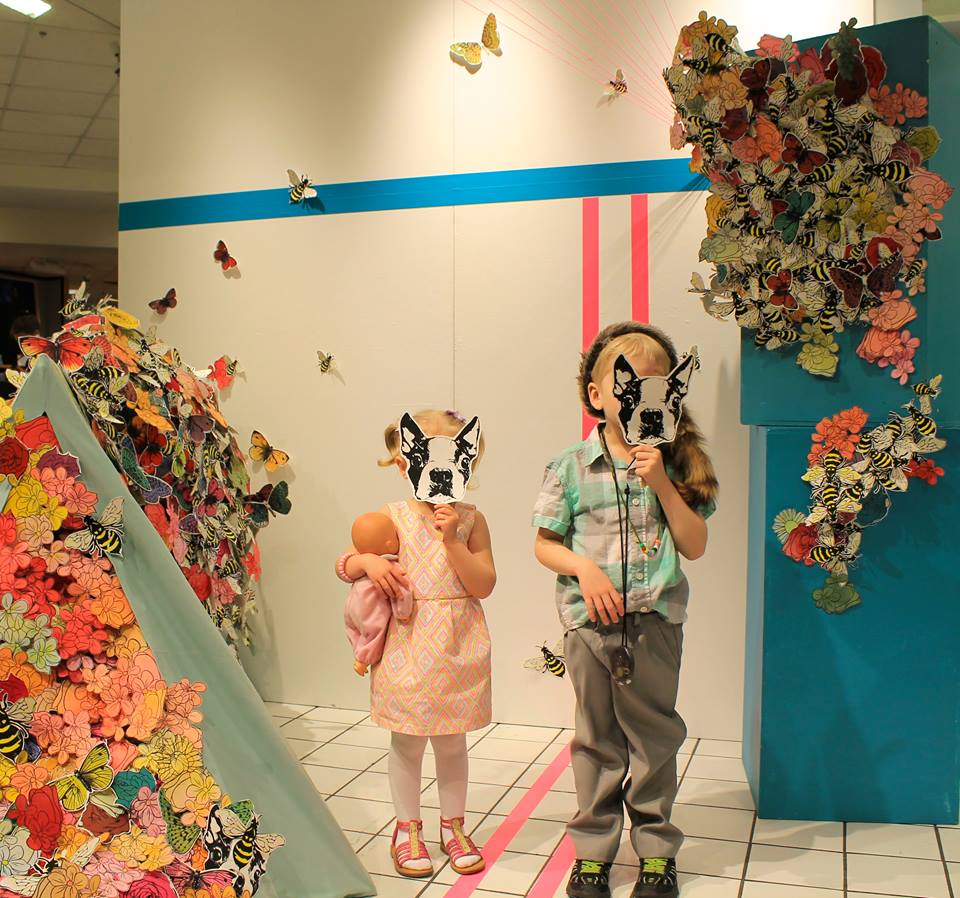
She always knew she was a creative person. She learned by creating with her hands and excelled at things that were process-oriented, but struggled with her education in school and just being happy where she was. “I was definitely not someone who was thriving at that point in my life, and I think it was due to my surroundings.”
Her mother convinced her to give college a try, at least for one semester. She attended Minnesota State University, Mankato, two hours south of Litchfield, where she got into scene design for theatre productions. “It was like night and day,” she says—her grades excelled as she took classes in theatre and visual arts and was surrounded by other creative people.
“I really began to understand growing into an adult and finding your creative pathway in a field,” she remembers. “Until that point I didn’t understand that’s what I wanted.”
Sikkila earned a bachelor’s of fine art in printmaking, and during that time she also got involved in the arts and culture scene outside of the university and exploring what “art” looks like in a community, especially in a small town like Mankato.
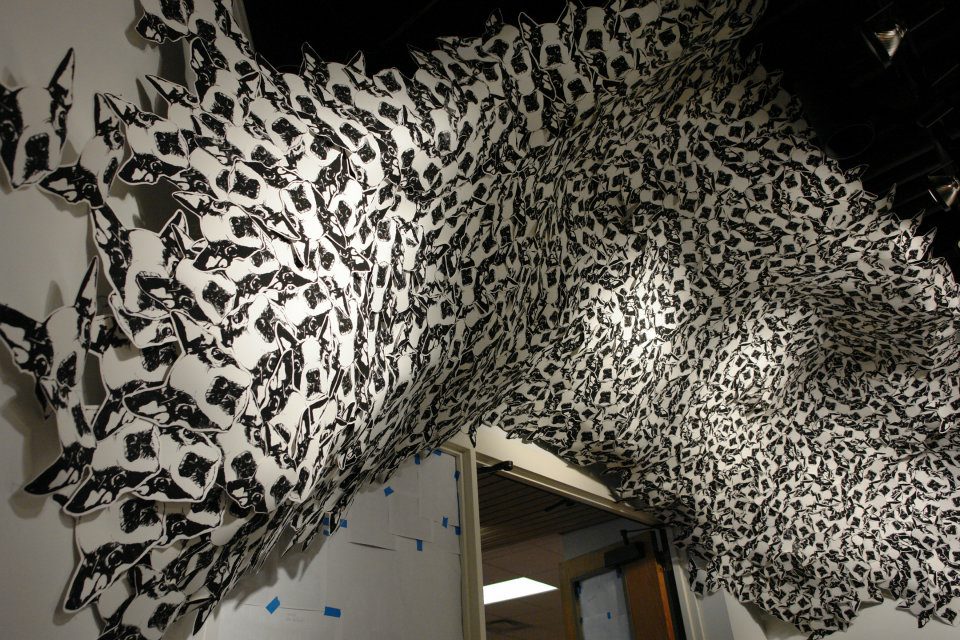
She continued on at the university to earn a master’s in printmaking. By her first year of graduate school she was regularly volunteering at the 410 Project, a volunteer-managed community arts space in downtown Mankato. MSU seniors had created the space several years earlier as a fun place to exhibit their work that wasn’t so formalized and regimented as traditional exhibit spaces. There was occasionally live music, but the space hadn’t really been “developed.”
While Sikkila was still working on her master’s, the then-director of the 410 Project, who also owned a small business in town, asked her if she was interested in taking over the space. At the time, she knew absolutely nothing about running an art space or managing a building and paying the bills, but she had planned and hung some art shows as an undergraduate and had a lot of artist friends in the community. She decided to go for it.
“I thought, how can I take what I’m really passionate about and how can it positively affect my friends, the people downtown we interact with, and the community outside of just me? So I took this leap and decided I’m going to run this art space,” she says. “It was kind of an overwhelming task, being this 25-year-old being in charge of this big building downtown and making sure it doesn’t shut down.”
She worked odd jobs and focused on developing the programming at the art space. Under her leadership, the 410 Project—which she is still Executive Director of today—has developed a youth mentorship program and become a full-fledged community arts space.
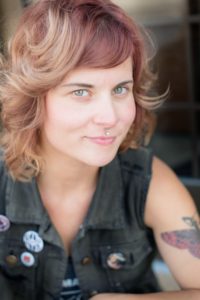
“What I do in any of my projects, whether 410 or anything else, is really try to give people of all ages opportunities to view work, show work, prove development, and really progress them to be able to sustain completely off their creative talents as adults,” Sikkila says.
A year or so after taking over the 410, she also began an arts leadership certificate program online.
‘It was like the two sides of my brain coming together—arts leadership and visual arts—and not everyone has that,” she says. “My career in the arts is a constant daily progression from one thing to another, and every day I have to balance these things with my practice as well.”
In addition to running the 410 and continuing her own practice creating prints, installations, and illustrations, Sikkila does arts administration work, public speaking, and teaches arts education and arts administration courses at the University of Minnesota, Mankato and Gustavus Adolphus College.
She participates in arts career development workshops and residencies as often as she can, like Springboard for the Arts’ Hinge Arts Residency, which she did in 2015 and again in 2018.
“Things like Hinge have helped me push forward in my visual practice and not be so bogged down by teaching and administrative work, but even then I still use it as an opportunity to teach and mentor other artists.”
After her first Hinge Arts Residency, Sikkila decided to follow a passion project that had long been in the back of her mind: Project Bike.
Project Bike started as a way for her to connect more Minnesota artists to Mankato and Mankato to more Minnesota artists. Every summer since 2015, Sikkila hops on a bike with a small trailer attached to the back and cycles around the state meeting Minnesota artists of all ages and collecting pieces of their work for an exhibit later held at the 410.
“I knew I didn’t just want all of our programming to be inside of this building. The 410 is not the building; it’s the people in it,” she says. “Mankato gets so stuck in its own community, and it’s true that that’s who we serve. But Project Bike is an expansion of our connection to the greater community outside of Mankato and a way for us to learn more about how people are making their work in other places. Also, a lot of Mankato artists leave and go other places and I thought, why aren’t we bringing artists into Mankato?”
Sikkila is a cycling enthusiast and thought it would be fun to bike around the state, meet other artists, learn more about their processes, collect pieces of their work to exhibit, and record it all to create a film to share with a wider audience.
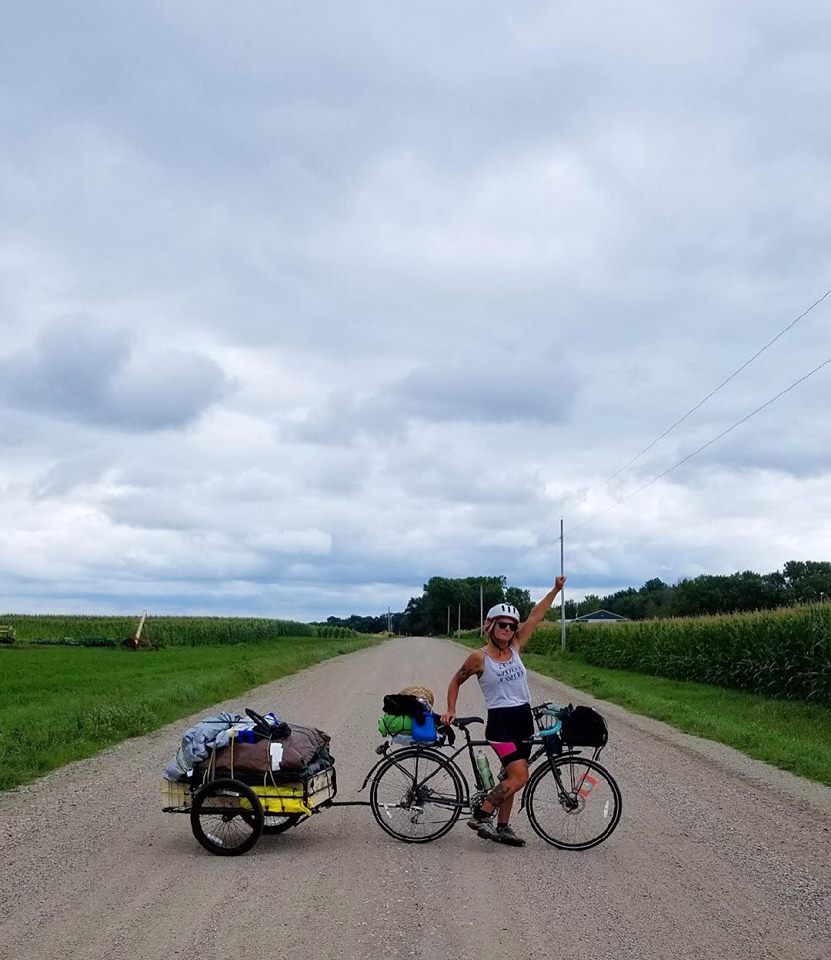
There were just a couple of small problems: She had never toured for more than a couple of days on a bike before, and she didn’t have any video equipment.
She applied for and received a $1,000 grant from the Prairie Lakes Regional Arts Council, had a moment of “Oh my God, now I have to do this thing” panic, got a bike trailer and some cheap GoPros, and hit the road on her bike for two weeks.
She biked by herself, collecting 12 pieces from 10 different artists that she also interviewed. When she got back home after the two-week ride, she swore she would never do it again.
“I had never been so mentally and physically drained,” she remembers. “I was biking in the rain. You’re literally living on a bicycle. You don’t know where you’re sleeping most nights. You’re depending on campgrounds. Plus being a female out biking around by yourself [has its own risks.]”
After that first outing she was able to convince two local filmmakers to help her piece together a short four-minute video from the footage she shot, and 80 people showed up at the opening to see it because they had been following Project Bike through social media and were “super into it.”
And so Sikkila found herself saying, “Okay, I guess I’ll do this again.”
Now she has a film crew of two plus herself and her riding partner Kyle Zeiszler, a physical trainer who offers Sikkila emotional support during the bike tour as well as his knowledge and skills as a bike mechanic.
410 Project Bike 17′ from GreyLightMedia on Vimeo.
Project Bike is now a statewide project. Each year they connect with artists who are farther and farther away throughout the state of Minnesota. They cover at least 10 artists of all ages and backgrounds working in all different mediums. Last year, one of the artists they covered was a 14-year-old who painted on his mom’s kitchen island.
“The whole purpose is to give people who maybe haven’t had these opportunities the chance to have their work displayed in an exhibit, be highlighted in this film and seen by other artists, and hopefully make some connections,” she says. “We also get to see where people are creating their work—sometimes it’s inside a huge warehouse, sometimes in a tiny corner of an apartment.”
They expanded to Fergus Falls last year after Sikkila participated in the Hinge Arts Residency alumni program. This was a part of the state they hadn’t toured through before, and they knew they could only be successful if they had a support system in the area.
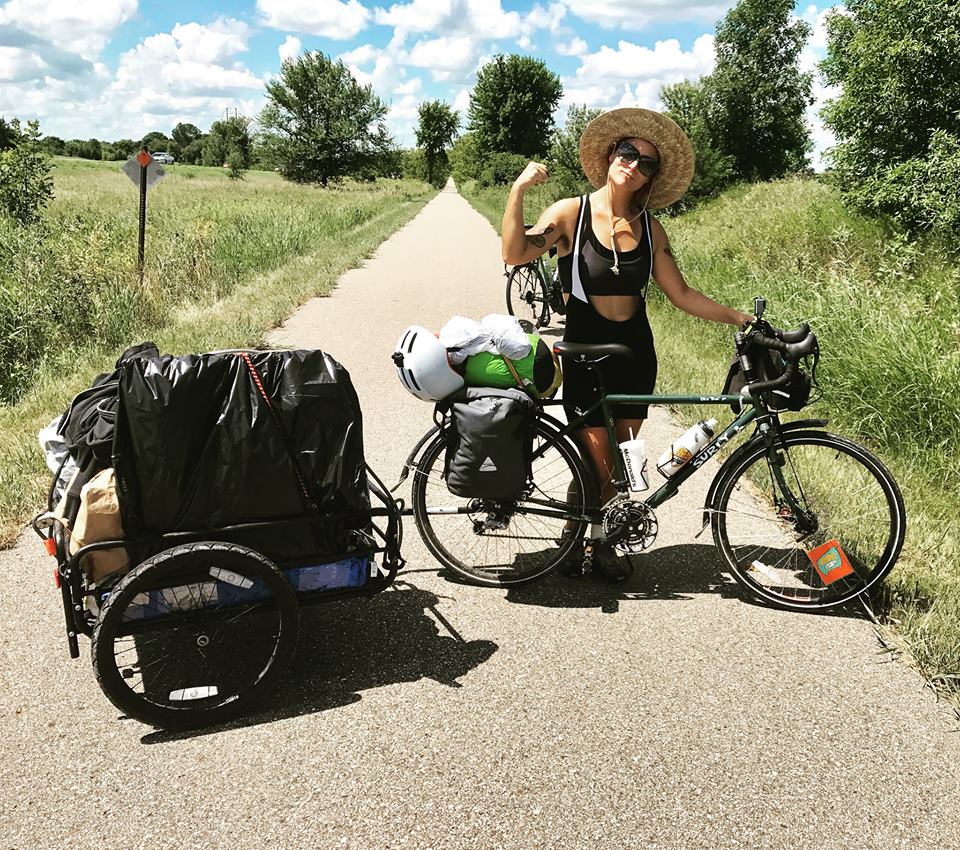
She says that one of the goals with Project Bike is to advocate for being an artist without having to live in a larger city in order to be successful.
“That’s been a huge thing for me to advocate for, especially for young people who think they have to move out of the state to be successful as an artist,” she explains. “Minnesota is one of the best states for creative people and creative careers [because of all the resources for artists available here]. I’ve had a lot of friends move out of Mankato and out of the state, but I never wanted to leave Minnesota because of all the opportunities I knew were here in terms of the arts and arts funding. Project Bike has been a great way to have those discussions.”
Sikkila hasn’t made any final decisions on whether or not Project Bike will happen again this year, but she is firm that if it does, this will be the last year. After four years of spending a significant chunk of her summer on a bike, she knows she has reached a point where it’s time to move on.
“I don’t work during the summer so that I can do Project Bike, and I save money all year to do this. All the grants and donations go to paying the filmmakers and maintaining the bikes. I put a lot of my own money into this and by the end of it I’m out of money. Kyle also has to take a whole month off of work, and he’s even said it would be nice to have his summers back.”
She adds, “It affects a lot of aspects of our lives. It’s a really big commitment for two people. But I also feel like the story isn’t quite finished yet.”
The project is very intensive and physically demanding: They’re on a very tight time schedule, so no matter how tired they are or how bad the weather is, they have to bike. Last year they spent 17 days on the road and biked 960 miles, with an ever-increasing weight load in the trailer—in total they collected 42 pieces from 15 artists and by the end, Sikkila’s trailer was over 200 pounds. The project requires a lot of fundraising but in the end, Sikkila doesn’t earn any income from it. She does all the planning herself to keep it grassroots and maintain that authentic human connection, but that means about half of her year is consumed by Project Bike.
And yet, Sikkila continues to be motivated by the overwhelming response from the community and how much people seem to enthusiastically engage with Project Bike. For the 2018 film screening along, hundreds of people from all over the state came to downtown Minneapolis to see the screening and interact with each other.
“Project Bike has been a crazy way of networking and growing,” she says. “When we show the film there are all these artists there meeting each other, and the idea is someone who’s watching it maybe doesn’t have a degree in painting and they make work in their basement, and then they see someone onscreen who also doesn’t have an art degree and makes work in their home. So others can watch the film and see themselves in it and say, ‘That’s me.’”
Whatever she decides to do this summer, Sikkila knows that both Project Bike and the 410 Project are the two big things she is best known for, and both were big gambles that paid off.
“None of this would have happened if I were not progressing, pushing forward, and networking all the time,” she says. “You have to have the hustle. You have to be motivated. A lot of people don’t take the time to develop or take those opportunities. But if I had said, ‘I’m not going to take the 410, it’s too much, I don’t know what I’m doing,’ I don’t even know who I would be now.”

(1) How do you like to collaborate?
Collaboration is one of the biggest things for me. I collaborate in all realms of my practices. I collaborate within my work with different mediums and materials. I collaborate a lot with other artists and organizations to figure out how we can work together with different community groups or diverse groups to create progression and support. Collaboration is a huge component in everything I do and I think it needs to be. With collaboration comes experimentation and that’s progression right there.
(2) How do you a start a project?
I always say I’m an idea person, and that can bite me in the butt sometimes but that’s how new ideas come to the table. I’m constantly thinking and starting something, whether an art piece or a big project, I’m always thinking, “What can I do to make this successful and who else or what else do I need or to learn to make this successful?”
(3) How do you talk about your value?
I do lot of public speaking now too and one of the things I think about is, what is the value of sharing your stories? To me, the value is the idea that people are able to learn or share emotion or empathy through the value of a person or a person’s story.
But then it gets into the value of someone making money. There are so many components of that word, “value,” but I think it’s really about understanding what you bring to the table. What is the value of yourself? That took me years and years and I still struggle with that.
That’s a tough question, especially in a creative field when you’re sustaining on your talents and constantly evaluating the value of your work and asking, “What is the impact of this work?” A lot of times that comes down to numbers, but also your connection to your audience and who your audience is. As creative people we underestimate the value of what we do, whether in finding outside resources or having discussions with yourself about what the “worth” of something is.
There’s value to everything; you just need to find someone who will value it.
(4) How do you define success?
What I feel is successful is truly I think in peoples’ response to a project, and it can be negative or positive. It’s success if it creates conversations or awareness and again, that can be negative or positive. Getting people to think about something in a different way—that’s how I define success.
As an event planner I can get really hung up on numbers: how many people were there, what was social engagement. Success is creating a continued conversation, but it’s also the learning component too—did someone learn something new? It could be about a print, like learning about the process of printmaking, or kind of more those mental or emotional sparks that come out of a project or experience. It’s also about how it motivates other people as well. As adults, how do we get and stay motivated? It gets more and more difficult to find those outlets as people—finding motivation and sparking motivation in myself and other people. For me especially, success is mental and emotional.
(5) How do you fund your work?
It’s literally a balance of a million things. I’m an educator, so that’s a form of steady income. I do a lot of individual mentoring, public speaking, illustrations. I apply for artist grants and organizational grants.
Funding what I want to do and the way that I want to live can be extremely stressful. It’s a constant ebb and flow of finances. It’s kind of all over but you really need to be able to look forward and know “how am I going to be paying my bills six months from now?”
I know that if I’m doing the bike tour this summer I need to make a ton of money this spring. How do I sell that portion of my business too? It’s a constant hustle of making money from all different areas. No amount of money is too small. I’ve taken workshops at Springboard and the only way I can go to them is because I got scholarships. It’s really being able to dive deep into funding. It’s constant working. It’s a stress you have to get used to, especially if it’s just you and you don’t have a partner for support. If you’re just an individual person you really have to crafty.
When people say to me, “I want to do what you’re doing,” I tell them to be prepared to work every single day and sometimes you have money and sometimes you don’t.

What a splendid article. Nicely done!